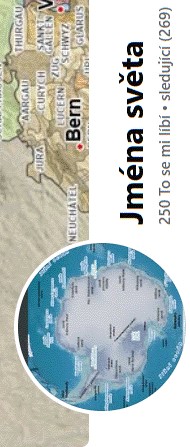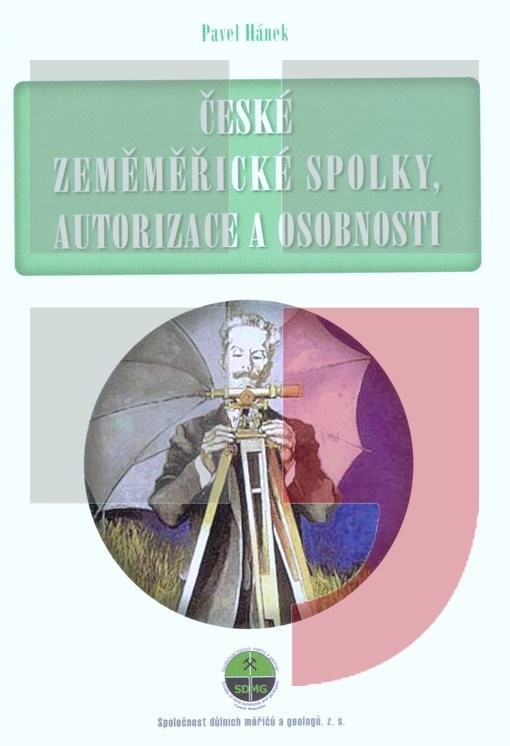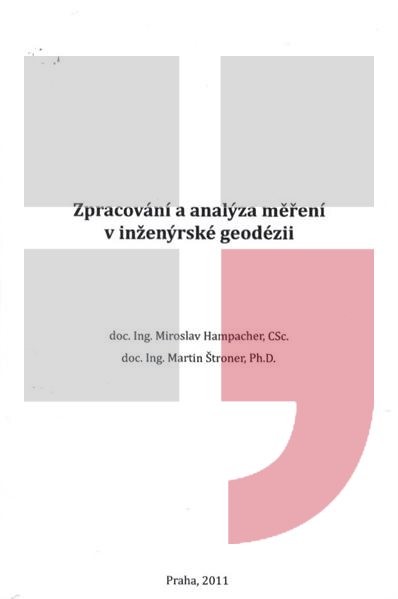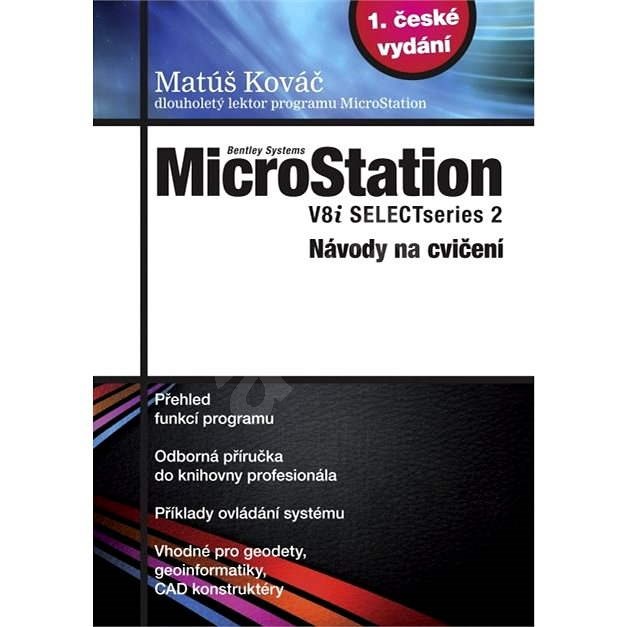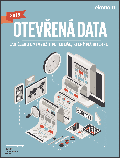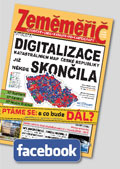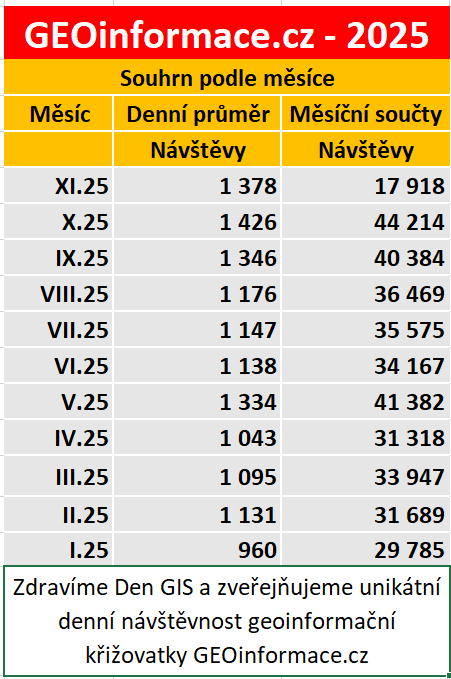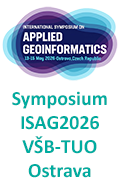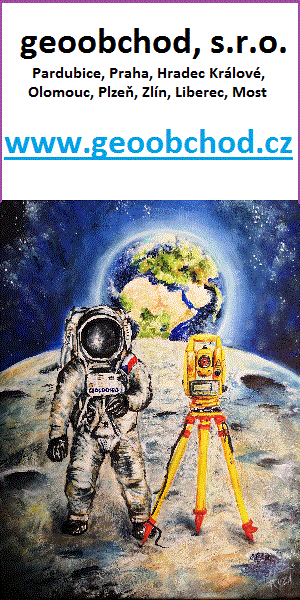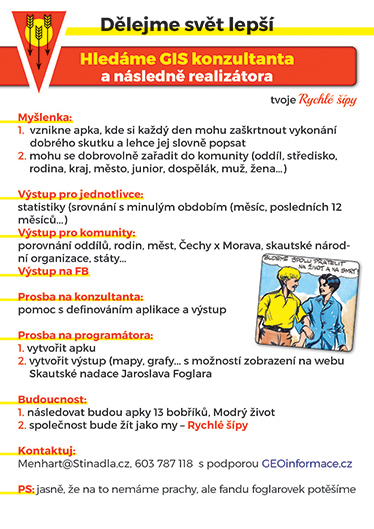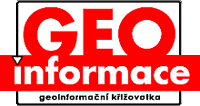zprávy
zdroje zpráv:Mapová aplikace Odpadové hospodářství
11.8.2015 13:50 Statutární město Ústí nad Labem Je vypublikována nová mapová aplikace ODPADOVÉ HOSPODÁŘSTVÍ. Aplikace obsahuje separovaný odpad (viditelné do M 1: 2000), kalendář svozu odpadu pro II. pololetí, odběrová místa pro elektroodpad a další informace.Workshopy 21. kartografické konference
11.8.2015 7:00 Česká asociace pro geoinformace Součástí 21. kartografické konference, která se uskuteční ve dnech 3. - 4. září 2015 v jihomoravské Lednici, bude i několik zajímavých workshopů, které proběhnou v předvečer konference (ve středu 2. září).Neváhejte a přihlašte
Vědecká knihovna hledá správce knihovního systému
10.8.2015 16:34 Katedra geoinformatiky UP Olomouc Informace pro absolventyVědecká knihovna v Olomouci vyhlašuje výběrové řízení na pozici správce knihovního systému
Požadavky:
vzdělání VŠ (SŠ s praxí) v oboru informačních technologií
logické a analytické myšlení
jazykové
Kvalitní WMS služba? Ano!
10.8.2015 12:00 TopGis Zpřístupňujeme rozsáhlou a průběžně aktualizovanou datovou základnu portálu MAPY.CZ. Máme pro vás připravených několik WMS služeb, které poskytují známé a populární mapové podklady. Co konkrétně jsme si pro vás nachystali? Výše uvedené – krom ortofotomapy – máme také pro území Slovenska. Takže, pokud již nejste spokojeni s kvalitou nyní využívaných mapových služeb. Chtěli byste lepší rozlišení.SIRO Selects Intergraph and IMGS for Fiber Broadband Project
10.8.2015 2:00 Hexagon Safety & InfrastructureSIRO, a joint venture company between ESB and Vodafone, has selected Intergraph's partner in Ireland, Irish Mapping & GIS Solutions Limited (IMGS), to supply and implement Intergraph software to aid in the planning, design and build-out of a 100-percent fiber-to-the-building broadband network.
SIRO will use Intergraph's commercial-off-the-shelf software, including Intergraph G/Technology, Fiber Optic Works and Hexagon Geospatial GeoMedia, to perform high-level network planning and design. Third-party contractors will also use the software to survey and build the fiber-to-the-building network. The Intergraph and IMGS solution will integrate with SIRO's operations support systems (OSS) and business support systems (BSS), including Amdocs Operations Support Systems (previously known as Cramer).
"IMGS and Intergraph were the obvious choice due to their experience and understanding of large-scale utility projects and experience with ESB Networks. SIRO required a dependable, dedicated and flexible partner to deliver this leading-edge, fiber-to-the-building GIS to meet SIRO's ambitious plans to bring the only 100-percent fiber network to Ireland," said John McIntyre, information technology director at SIRO.
SIRO selected Intergraph and IMGS based on ESB's existing relationship with the companies. An Intergraph customer for 20 years, ESB Networks Ltd., an ESB subsidiary and the licensed operator of the electricity distribution system in the Republic of Ireland, worked with Intergraph and IMGS to implement a geographic information system (GIS) to support the planning, design, construction and day-to-day operations of Ireland's electricity distribution network.
"SIRO required a trusted and reliable partner to deliver the software necessary to implement the new fiber network," said Alun Pearsey, U.K. country manager, Intergraph Security, Government and Infrastructure (SG&I). "Working with IMGS, we are rapidly deploying a proven, flexible solution that can consume the electric network data on which the fiber network will be built. We are proud to assist ESB and Vodafone is this critically important endeavor."
SIRO is investing €450 million in building Ireland's first 100-percent fiber-to-the-building broadband network, offering speeds up to 1000 Mbps to 500,000 premises in 50 regional towns, revolutionizing the broadband market in Ireland. The network will be built on ESB's existing over ground and underground electricity infrastructure.
"For Ireland's knowledge economy to continue to grow, a world-class communications network is critical," said Ciaran Kirk, general manager, IMGS. "SIRO will ensure businesses and consumers across the country can access super-fast broadband. The Intergraph GIS will be fundamental in ensuring an efficient roll out and maintenance of this critical service."
Intergraph SG&I helps utilities and communications companies streamline work processes and make smarter decisions. A pioneer in the development and application of location-based technology for more than 45 years, Intergraph SG&I provides solutions to hundreds of utilities and communications customers around the globe, supporting network engineering and operations, customer services and more.
SIRO Selects Intergraph and IMGS for Fiber Broadband Project
10.8.2015 2:00 Hexagon Safety & InfrastructureSIRO, a joint venture company between ESB and Vodafone, has selected Intergraph's partner in Ireland, Irish Mapping & GIS Solutions Limited (IMGS), to supply and implement Intergraph software to aid in the planning, design and build-out of a 100-percent fiber-to-the-building broadband network.
SIRO will use Intergraph's commercial-off-the-shelf software, including Intergraph G/Technology, Fiber Optic Works and Hexagon Geospatial GeoMedia, to perform high-level network planning and design. Third-party contractors will also use the software to survey and build the fiber-to-the-building network. The Intergraph and IMGS solution will integrate with SIRO's operations support systems (OSS) and business support systems (BSS), including Amdocs Operations Support Systems (previously known as Cramer).
"IMGS and Intergraph were the obvious choice due to their experience and understanding of large-scale utility projects and experience with ESB Networks. SIRO required a dependable, dedicated and flexible partner to deliver this leading-edge, fiber-to-the-building GIS to meet SIRO's ambitious plans to bring the only 100-percent fiber network to Ireland," said John McIntyre, information technology director at SIRO.
SIRO selected Intergraph and IMGS based on ESB's existing relationship with the companies. An Intergraph customer for 20 years, ESB Networks Ltd., an ESB subsidiary and the licensed operator of the electricity distribution system in the Republic of Ireland, worked with Intergraph and IMGS to implement a geographic information system (GIS) to support the planning, design, construction and day-to-day operations of Ireland's electricity distribution network.
"SIRO required a trusted and reliable partner to deliver the software necessary to implement the new fiber network," said Alun Pearsey, U.K. country manager, Intergraph Security, Government and Infrastructure (SG&I). "Working with IMGS, we are rapidly deploying a proven, flexible solution that can consume the electric network data on which the fiber network will be built. We are proud to assist ESB and Vodafone is this critically important endeavor."
SIRO is investing €450 million in building Ireland's first 100-percent fiber-to-the-building broadband network, offering speeds up to 1000 Mbps to 500,000 premises in 50 regional towns, revolutionizing the broadband market in Ireland. The network will be built on ESB's existing over ground and underground electricity infrastructure.
"For Ireland's knowledge economy to continue to grow, a world-class communications network is critical," said Ciaran Kirk, general manager, IMGS. "SIRO will ensure businesses and consumers across the country can access super-fast broadband. The Intergraph GIS will be fundamental in ensuring an efficient roll out and maintenance of this critical service."
Intergraph SG&I helps utilities and communications companies streamline work processes and make smarter decisions. A pioneer in the development and application of location-based technology for more than 45 years, Intergraph SG&I provides solutions to hundreds of utilities and communications customers around the globe, supporting network engineering and operations, customer services and more.
SIRO Selects Intergraph and IMGS for Fiber Broadband Project
10.8.2015 2:00 Hexagon Safety & InfrastructureSIRO, a joint venture company between ESB and Vodafone, has selected Intergraph's partner in Ireland, Irish Mapping & GIS Solutions Limited (IMGS), to supply and implement Intergraph software to aid in the planning, design and build-out of a 100-percent fiber-to-the-building broadband network.
SIRO will use Intergraph's commercial-off-the-shelf software, including Intergraph G/Technology, Fiber Optic Works and Hexagon Geospatial GeoMedia, to perform high-level network planning and design. Third-party contractors will also use the software to survey and build the fiber-to-the-building network. The Intergraph and IMGS solution will integrate with SIRO's operations support systems (OSS) and business support systems (BSS), including Amdocs Operations Support Systems (previously known as Cramer).
"IMGS and Intergraph were the obvious choice due to their experience and understanding of large-scale utility projects and experience with ESB Networks. SIRO required a dependable, dedicated and flexible partner to deliver this leading-edge, fiber-to-the-building GIS to meet SIRO's ambitious plans to bring the only 100-percent fiber network to Ireland," said John McIntyre, information technology director at SIRO.
SIRO selected Intergraph and IMGS based on ESB's existing relationship with the companies. An Intergraph customer for 20 years, ESB Networks Ltd., an ESB subsidiary and the licensed operator of the electricity distribution system in the Republic of Ireland, worked with Intergraph and IMGS to implement a geographic information system (GIS) to support the planning, design, construction and day-to-day operations of Ireland's electricity distribution network.
"SIRO required a trusted and reliable partner to deliver the software necessary to implement the new fiber network," said Alun Pearsey, U.K. country manager, Intergraph Security, Government and Infrastructure (SG&I). "Working with IMGS, we are rapidly deploying a proven, flexible solution that can consume the electric network data on which the fiber network will be built. We are proud to assist ESB and Vodafone is this critically important endeavor."
SIRO is investing €450 million in building Ireland's first 100-percent fiber-to-the-building broadband network, offering speeds up to 1000 Mbps to 500,000 premises in 50 regional towns, revolutionizing the broadband market in Ireland. The network will be built on ESB's existing over ground and underground electricity infrastructure.
"For Ireland's knowledge economy to continue to grow, a world-class communications network is critical," said Ciaran Kirk, general manager, IMGS. "SIRO will ensure businesses and consumers across the country can access super-fast broadband. The Intergraph GIS will be fundamental in ensuring an efficient roll out and maintenance of this critical service."
Intergraph SG&I helps utilities and communications companies streamline work processes and make smarter decisions. A pioneer in the development and application of location-based technology for more than 45 years, Intergraph SG&I provides solutions to hundreds of utilities and communications customers around the globe, supporting network engineering and operations, customer services and more.
U mapové aplikace Územně analy
8.8.2015 12:00 Jihočeský kraj U mapové aplikace Územně analytické podklady byly aktualizovány mapové dlaždice k 8. 8. 2015.U mapové aplikace byly aktual
8.8.2015 12:00 Jihočeský kraj U mapové aplikace byly aktualizovány mapové dlaždice k 8. 8. 2015.Do FAQ v diskusním fóru byl př
7.8.2015 15:36 GEUSware Do FAQ v diskusním fóru byl přidán článek, který se zprovoznění našich programů v prostředí Windows 10 věnuje. Je tam pouze menší problém s instalací driverů klíčů HASP, ty je zatím nutné instalovat ručně. Automaticky nainstalované drivery s našimi programy zatím nefungují. Více naleznete v diskusním fóru eSupportVe všech mapových službách byl
7.8.2015 12:00 Plzeňský kraj Ve všech mapových službách byla provedena aktualizace vektorových katastrálních map (DKM, KMD a ÚKM). Data jsou s platností k 1. 7. 2015. Nově je v DKM zpracováno 18 katastrálních území. Stav digitalizace je k dispozici zde. Pro práci s daty katastru nemovitostí je možné například využít tuto mapovou službu. Seznam všech mapových služeb je k dispozici zde. Zároveň došlo k aktualizaci dat ve výdejním modulu.Ve všech mapových službách byl
7.8.2015 12:00 Plzeňský kraj Ve všech mapových službách byla provedena aktualizace vektorových katastrálních map (DKM, KMD a ÚKM). Data jsou s platností k 1. 7. 2015. Nově je v DKM zpracováno 18 katastrálních území. Stav digitalizace je k dispozici zde (http://cuzk.cz/Dokument.aspx?AKCE=META:SESTAVA:MDR004_XSLT:WEBCUZK_KRAJ:400). Pro práci s daty katastru nemovitostí je možné například využít tuto mapovou službu (http://mapy.kr-plzensky.cz/gis/katastr/). Seznam všech mapových služeb je k dispozici zde (http://geoportal.plzensky-kraj.cz/gs/vsechny-mapy/). Zároveň došlo k aktualizaci dat ve výdejním modulu.ESA Young Graduate Trainee 2016
7.8.2015 7:00 Česká asociace pro geoinformaceEvropská kosmická agentura (ESA) realizuje v rámci svých korporátních vzdělávacích aktivit program „Young Graduate Trainee (YGT)“. Jedná se o jednoletý stipendijní program, který je určený vysokoškolským studentům dokončujícím své studium, čerstvým absolventům a studentům doktorských programů.
Studenti a absolventi vysokých škol mají skrze program YGT
Jaká byla letošní evropská INSPIRE konference?
7.8.2015 7:00 Česká asociace pro geoinformace Zajímá vás jaká byla letošní evropská INSPIRE konference? Potom si prostudujte detailní zprávu z konference, která se uskutečnila na konci května v portugalskémSave the date - 4. eCall Testfest Workshop, Ostrava, listopad 2015
6.8.2015 10:59 Český Kosmický PortálEvropské organizace ERTICO a ETSI pořádají ve dnech 9. - 13. listopadu 2015 v Ostravě v pořadí již čtvrtý eCall Testfest workshop, který bude zaměřen na testování interoperability systému eCall. Tato událost bude hostována společností VÍTKOVICE IT SOLUTIONS a.s. ve spolupráci s Ministerstvem dopravy, Ministerstvem vnitra a Hasičským záchranným sborem České republiky.
Save the date - 4. eCall Testfest Workshop, Ostrava, listopad 2015
6.8.2015 10:59 Český Kosmický PortálEvropské organizace ERTICO a ETSI pořádají ve dnech 9. - 13. listopadu 2015 v Ostravě v pořadí již čtvrtý eCall Testfest workshop, který bude zaměřen na testování interoperability systému eCall. Tato událost bude hostována společností VÍTKOVICE IT SOLUTIONS a.s. ve spolupráci s Ministerstvem dopravy, Ministerstvem vnitra a Hasičským záchranným sborem České republiky.
Save the date - 4. eCall Testfest Workshop, Ostrava, listopad 2015
6.8.2015 10:59 Český Kosmický PortálEvropské organizace ERTICO a ETSI pořádají ve dnech 9. - 13. listopadu 2015 v Ostravě v pořadí již čtvrtý eCall Testfest workshop, který bude zaměřen na testování interoperability systému eCall. Tato událost bude hostována společností VÍTKOVICE IT SOLUTIONS a.s. ve spolupráci s Ministerstvem dopravy, Ministerstvem vnitra a Hasičským záchranným sborem České republiky.
Konference Mapování | GIS | Rozvojové země
4.8.2015 7:00 Česká asociace pro geoinformaceKatedra rozvojových studií PřF UP Olomouc Vás zve na třetí ročník konference Mapování | GIS | Rozvojové země, která se snad pomalu stává tradicí lákající do Olomouce zájemce nejen o rozvojové země, ale také o možnosti využití geografických informačních systémů (GIS) a mapování v těchto oblastech.
Letošní ročník se bude konat:
Kdy: pátek 16. 10. 2015,
Mapa světa jako Voroného diagram
3.8.2015 7:00 Česká asociace pro geoinformace Jak by vypadal svět, kdyby současná hlavní města tvořila množinu bodů generující Voroného diagram a hranice příslušných států by tedy byly totožné z hranicemi buněk Voroného diagramu? Podívejte se na tuto zajímavouSklonitost
3.8.2015 2:00 Cenia - Katalog metadat ČR - INSPIRE Mapa sklonitosti zemědělské půdy, mapa velkého měřítka.Expozice
3.8.2015 2:00 Cenia - Katalog metadat ČR - INSPIRE Mapa expozice zemědělské půdy, mapa velkého měřítka.V datech územně analytických p
31.7.2015 12:00 Plzeňský kraj V datech územně analytických podkladů Plzeňského kraje byla provedena aktualizace dat technické infrastruktury od poskytovatele RWE GasNet, s.r.o. Data jsou s platností k 27. 7. 2015.V datech územně analytických p
31.7.2015 12:00 Plzeňský kraj V datech územně analytických podkladů Plzeňského kraje byla provedena aktualizace dat technické infrastruktury od poskytovatele RWE GasNet, s.r.o. (http://geoportal.plzensky-kraj.cz/gs/rss?url=http%3A%2F%2Fgeoportal.plzensky-kraj.cz%2Ftw%2Fost%2Fgp%2Fuap%2Fposkytovatele%2Findex.php%3Fframe%26ID%3D540) Data jsou s platností k 27. 7. 2015.Čínská družice Gaofen-2 byla uvedena do plného provozu.
30.7.2015 17:00 Gisat Družice Gaofen-2 (zkráceně GF-2) byla oficiálně uvedena do plného provozu v březnu 2015. Družice z oběžné dráhy ve výšce 631 km snímá nejpodrobnější obrazová data v rozlišení až 80 cm.Ve výdejním modulu je možné žá
30.7.2015 12:00 Jihočeský kraj Ve výdejním modulu je možné žádat o data katastru nemovitostí platná k 1. 7. 2015.Akční plán GeoInfoStrategie byl schválen
30.7.2015 7:00 Česká asociace pro geoinformaceAkční plán GeoInfoStrategie byl schválen usnesením vlády ČR ze dne 8. července 2015 č. 539.
Usnesení i schválená verze jsou k dispozici na www.geoinfostrategie.gov.cz (pod bodem 8. Akční plán GeoInfoStrategie).
Akční plán GeoInfoStrategie byl schválen usnesením vlády ČR ze dne 8. července 2015 č. 539.
Usnesení i schválená verze jsou k dispozici na webové
Byla provedena komplexní aktua
27.7.2015 12:00 Plzeňský kraj Byla provedena komplexní aktualizace mapových služeb územně analytických podkladů obcí s rozšířenou působností a Plzeňského kraje. Ve složce Územně analytické podklady ORP jsou nově k dispozici různé mapové služby, které obsahují průběžně aktualizovaná sjednocená data územně analytických podkladů. Zároveň došlo ke změně adres pro poskytování těchto dat prostřednictvím Webových Mapových Služeb.Byla provedena komplexní aktua
27.7.2015 12:00 Plzeňský kraj Byla provedena komplexní aktualizace mapových služeb územně analytických podkladů obcí s rozšířenou působností a Plzeňského kraje. Ve složce Územně analytické podklady ORP (http://geoportal.plzensky-kraj.cz/gs/uzemne-analyticke-podklady-orp/) jsou nově k dispozici různé mapové služby, které obsahují průběžně aktualizovaná sjednocená data územně analytických podkladů. Zároveň došlo ke změně adres pro poskytování těchto dat prostřednictvím Webových Mapových Služeb (http://geoportal.plzensky-kraj.cz/gs/webove-sluzby/).Vyhlášení platnosti (2)
27.7.2015 7:05 ČÚZK - předpisy a opatření Vyhlášení platnosti obnoveného katastrálního operátu na části k.ú. Hrabětice č.j. OO - 7/2014Vyhlášení platnosti (2)
27.7.2015 7:05 ČÚZK - předpisy a opatření Vyhlášení platnosti obnoveného katastrálního operátu na části k.ú. Hrabětice č.j. OO - 7/2014Vyhlášení platnosti (2)
27.7.2015 7:05 ČÚZK - předpisy a opatření Vyhlášení platnosti obnoveného katastrálního operátu na části k.ú. Hrabětice č.j. OO - 7/2014Vyhlášení platnosti (2)
27.7.2015 7:05 ČÚZK - předpisy a opatření Vyhlášení platnosti obnoveného katastrálního operátu na části k.ú. Hrabětice č.j. OO - 7/2014Aktuálně: 21 serpentin na Alpe d'Huez
25.7.2015 7:00 Česká asociace pro geoinformace Kolumbijec Nairo Quintana v sobotu odpoledne zle potrápil britského závodníka Chrise Frooma v legendárním stoupání na Alpe d'Huez. Na celkové vítězství v letošním ročníku cyklistické Tour de France mu to však nestačilo. My ostatní se můžeme v klidu podívat na pěknou mapovou vizualizaci legendárních 2123. středoevropská geografická konference
25.7.2015 7:00 Česká asociace pro geoinformace Katedra geografie Pedagogické fakulty Masarykovy univerzity v Brně srdečně zve všechny zájemce o geografii na 23. ročník středoevropské geografické konference, která se uskuteční ve dnech 8. a 9. října v Brně.Jednání se budou odehrávat v těchto základních sekcích: Krajina jako laboratoř, Užitečná geografie, Digitální geografická data a Geografické vzdělávání.
Pozvánka na prázdninové školení MISYS
25.7.2015 7:00 Česká asociace pro geoinformace Společnost GEFOS, kolektivní člen CAGI, Vás srdečně zve na prázdninové školení MISYS, které se bude konat 25. 8. 2015 na adrese společnosti: Plánská 6, 370 07 České Budějovice.Začátek školení je plánován na 9:00. Registrace účastníků bude probíhat od 8:30 ve vestibulu budovy u hlavního vchodu.
Toto obecné školení bude určeno všem uživatelům, kteří si
V datech územně analytických p
22.7.2015 12:00 Plzeňský kraj V datech územně analytických podkladů Plzeňského kraje byla provedena aktualizace dat technické infrastruktury od poskytovatele ČEZ Distribuce, a. s. (http://geoportal.plzensky-kraj.cz/gs/rss?url=http%3A%2F%2Fgeoportal.plzensky-kraj.cz%2Ftw%2Fost%2Fgp%2Fuap%2Fposkytovatele%2Findex.php%3Fframe%26ID%3D19) a ČEZ ICT Services, a. s. (http://geoportal.plzensky-kraj.cz/gs/rss?url=http%3A%2F%2Fgeoportal.plzensky-kraj.cz%2Ftw%2Fost%2Fgp%2Fuap%2Fposkytovatele%2Findex.php%3Fframe%26ID%3D75) Data jsou s platností k 1. 7. 2015.V datech územně analytických p
22.7.2015 12:00 Plzeňský kraj V datech územně analytických podkladů Plzeňského kraje byla provedena částečná aktualizace dat od poskytovatele Agentura ochrany přírody a krajiny České republiky (http://geoportal.plzensky-kraj.cz/gs/rss?url=http%3A%2F%2Fgeoportal.plzensky-kraj.cz%2Ftw%2Fost%2Fgp%2Fuap%2Fposkytovatele%2Findex.php%3Fframe%26ID%3D1). Jedná se o data jevů č. 28, 31, 32 a 119.V datech územně analytických p
22.7.2015 12:00 Plzeňský kraj V datech územně analytických podkladů Plzeňského kraje byla provedena částečná aktualizace dat od poskytovatele Agentura ochrany přírody a krajiny České republiky. Jedná se o data jevů č. 28, 31, 32 a 119.V datech územně analytických p
22.7.2015 12:00 Plzeňský kraj V datech územně analytických podkladů Plzeňského kraje byla provedena aktualizace dat technické infrastruktury od poskytovatele ČEZ Distribuce, a. s. a ČEZ ICT Services, a. s. Data jsou s platností k 1. 7. 2015.Aktualizace verze TopoL xT 10.0
21.7.2015 12:00 Topol Software Je připravena nová aktualizace verze TopoL xT 10.0.9, která je ke stažení na našich stránkách.Atlas EROZE
20.7.2015 15:00 Atlas EROZE je rozšířením programu Atlas DMT, které je určeno pro hodnocení erozní ohroženosti zemědělských pozemkůV datech územně analytických p
19.7.2015 12:00 Plzeňský kraj V datech územně analytických podkladů Plzeňského kraje byla provedena aktualizace vrstvy BPEJ (bonitovaná půdně ekologická jednotka od poskytovatele Výzkumný ústav meliorací a ochrany půdy, v.v.i.. Data jsou s platností k 7. 7. 2016.V datech územně analytických p
19.7.2015 12:00 Plzeňský kraj V datech územně analytických podkladů Plzeňského kraje byla provedena aktualizace vrstvy BPEJ (bonitovaná půdně ekologická jednotka od poskytovatele Výzkumný ústav meliorací a ochrany půdy, v.v.i. (http://geoportal.plzensky-kraj.cz/gs/rss?url=http%3A%2F%2Fgeoportal.plzensky-kraj.cz%2Ftw%2Fost%2Fgp%2Fuap%2Fposkytovatele%2Findex.php%3Fframe%26ID%3D2). Data jsou s platností k 7. 7. 2016.Aktualizovaný program ROEPdat, verzia 2.12.
17.7.2015 12:45 Výskumný ústav geodézie a kartografie v Bratislave Aktualizovaný program ROEPdat, verzia 2.12.Byla provedena aktualizace map
17.7.2015 12:00 Plzeňský kraj Byla provedena aktualizace mapové služby Přehled stavu komplexních a jednoduchých pozemkových úprav. Data byla aktualizována k 1.7.2015.Byla provedena aktualizace map
17.7.2015 12:00 Plzeňský kraj Byla provedena aktualizace mapové služby Přehled stavu komplexních a jednoduchých pozemkových úprav (http://mapy.kr-plzensky.cz/gis/pozemkove_upravy). Data byla aktualizována k 1.7.2015.Geomatika v projektech 2015
17.7.2015 7:00 Česká asociace pro geoinformace Ve dnech 7. a 8. října 2015 pořádá na zámku Kozel Západočeská univerzita v Plzni, Fakulta aplikovaných věd, Katedra matematiky, oddělení geomatiky tradiční konferenci Geomatika v projektech.Hlavní témata letošního ročníku:
• Geomatika v dopravě
• Geomatika a geoprostorové kulturní dědictví
• Aplikace teoretické geodézie
•
Nové předměty
15.7.2015 16:04 Katedra geoinformatiky UP Olomouc Studenti,pro nadcházející akademický rok pro vás připravila katedra geoinformatiky nové, odborně zaměřené doplňující předměty (předměty C). Všechny předměty mají dotaci dvou hodin týdně a jsou zakončeny zápočtem. Zapište se n
Dříve obyčejný student, dnes jeden z nejúspěšnějších absolventů
14.7.2015 15:13 Cleerio V roce 2010 dokončil Ladislav Čapek studium na University of New York in Prague, kde obdržel prestižní titul MBA. Spolu s ním opouštěl univerzitu i Jan Zvoník, nynější CTO. Zajímavé je, že firma Geosense (nyní Cleerio) již v té době existovala, jak to?Dříve obyčejný student, dnes jeden z nejúspěšnějších absolventů
14.7.2015 12:00 Cleerio Roku 2010 dokončil jednatel naší společnosti Ladislav Čapek studium na University of New York in Prague, kde obdržel prestižní titul MBA. Spolu s ním opouštěl univerzitu se stejným titulem i Jan Zvoník, nynější technický ředitel. Zajímavé je, že firma Geosense již v té době existovala. Dva spoluzakladatelé totiž firmu vytvořili už při svých studiích. Na nápadu, který o pár let později přinesl revoluční přístup ke správě majetku pomocí online mapové aplikace, společně pracovali už od roku 2009. Obchodní plán společnosti byl dokonce součástí jejich absolventské práce. O tom, že byl předurčen k úspěchu, dnes hovoří přes 1400 spokojených zákazníků. Univerzita letos pana Čapka kontaktovala a požádala jej o svolení zařadit jeho příběh mezi tzv. „success stories“. Ladislav se tak zařadil mezi desítku absolventů, kteří uspěli nejen ve škole, ale zaznamenali také velký úspěch ve své následné kariéře. Zatím v angličtině můžete článek číst na...Byla vytvořena aplikace doprav
14.7.2015 12:00 Ústecký krajByla vytvořena aplikace dopravní infrastruktury v Ústeckém kraji v novém mapovém prostředí Javascript. Tato aplikace byla vytvořena primárně pro desktop PC, ale bezproblémů lze tuto mapovou aplikaci zobrazovat i na mobilních zařízeních (tablety, telefony).
Mapovou aplikaci naleznete v sekci MAPY - > Doprava a silniční hospodářství - > Mapa dopravní infrastruktury Ústeckého kraje.Living Planet Symposium 2016
14.7.2015 7:00 Česká asociace pro geoinformace Symposium Living Planet je nejrozsáhlejší akcí Evropské kosmické agentury (ESA) v oblasti pozorování Země. Koná se jednou za tři roky a jeho nadcházející ročník proběhne ve dnech 8. – 13. května 2016 v Kongresovém centru v Praze. Hlavním organizátorem symposia je ESA, spoluorganizátory akce jsou pak Ministerstvo dopravy, Ministerstvo životního prostředí a Ministerstvo21. kartografická konference - detailní program
14.7.2015 7:00 Česká asociace pro geoinformace Organizátoři 21. kartografické konference, která se uskuteční ve dnech 3. a 4. září 2015 v jihomoravské Lednici, zveřejnili její detailníVypublikovány nové mapové aplikace
13.7.2015 14:00 Statutární město Ústí nad Labem Úsek GIS vypublikoval nové mapové aplikace:Památková péče
Ochrana přírody a krajiny
Školství
Odbor regionálního rozvoje Kra
13.7.2015 12:00 Plzeňský kraj Odbor regionálního rozvoje Krajského úřadu Plzeňského kraje pořídil v souladu s požadavky zákona č. 183/2006 Sb. úplnou aktualizaci Územně analytických podkladů Plzeňského kraje 2015, kterou dne 8. 6. 2015 projednalo Zastupitelstvo Plzeňského kraje svým usnesením č. 859/15. Kompletní dokumentace je k dispozici zde (http://geoportal.plzensky-kraj.cz/gs/uap-pk-2015/)Odbor regionálního rozvoje Kra
13.7.2015 12:00 Plzeňský kraj Odbor regionálního rozvoje Krajského úřadu Plzeňského kraje pořídil v souladu s požadavky zákona č. 183/2006 Sb. úplnou aktualizaci Územně analytických podkladů Plzeňského kraje 2015, kterou dne 8. 6. 2015 projednalo Zastupitelstvo Plzeňského kraje svým usnesením č. 859/15. Kompletní dokumentace je k dispozici zdeOR_ve_zneni_dod_1_a_2_internet
9.7.2015 12:45 ČÚZK - předpisy a opatření /Urady/Katastralni-urady/Katastralni-urady/Katastralni-urad-pro-Vysocinu/O-uradu/Statut-Organizacni-rad-Jednaci-rad/Organizacni_rad_KUStaré ekologické zátěže
9.7.2015 2:00 Cenia - Katalog metadat ČR - INSPIRE Staré ekologické zátěže, Zlínský kraj, 2011Obraz katastrální mapy
9.7.2015 2:00 Cenia - Katalog metadat ČR - INSPIRE Obraz katastrální mapy Zlínského kraje.Stav dat k 1. 7. 2018. Vznik spojením DKM, KMD, KM-D a ÚKM(orientační mapy parcel - vektorové).Schválena Strategie implementace INSPIRE
8.7.2015 7:00 Česká asociace pro geoinformaceVedení Ministerstva životního prostředí schválilo v závěru června 2015 Strategii implementace INSPIRE.
Strategie implementace INSPIRE je v rámci České republiky základním dokumentem pro realizaci požadavků vyplývajících ze směrnice Evropského parlamentu a Rady 2007/2/ES o zřízení Infrastruktury pro prostorové informace v Evropském společenství (INSPIRE).
Vedení
Konference Inspirujme se... - první informace
8.7.2015 7:00 Česká asociace pro geoinformace Letošní ročník konference Inspirujme se..., která se zaměřuje na implementaci směrnice INSPIRE v ČR, proběhne v Bratislavě v hotelu Tatra ve dnech 24. aGefos zve na školení MISYS
8.7.2015 7:00 Česká asociace pro geoinformace Společnost Gefos a.s., kolektivní člen CAGI, Vás srdečně zve na prázdninové školení MISYS, které se bude konat 25. 8. 2015 na adrese společnosti: Plánská 6, 370 07 České Budějovice.Začátek školení je plánován na 9:00. Registrace účastníků bude probíhat od 8:30 ve vestibulu budovy u hlavního vchodu.
Toto obecné školení bude určeno všem uživatelům,
20150703 - Mluvnické charakteristiky
3.7.2015 10:28 ČÚZK /Uvod/Produkty-a-sluzby/RUIAN/RUIAN-novinky/2015/20150703-Mluvnicke-charakteristiky20150703 - Mluvnické charakteristiky
3.7.2015 10:28 ČÚZK - předpisy a opatření /Uvod/Produkty-a-sluzby/RUIAN/RUIAN-novinky/2015/20150703-Mluvnicke-charakteristikyLetní novinky v produktech CEDA
2.7.2015 13:45 CEDA Maps a.s. Pravidelné letní vydání aktualizací geodatabází StreetNet a POI. Rozšíření nadstaveb NAV a TOURIST. Zahájen prodej POI zastávek hromadné dopravy. Novinka: StreetNet CROSSBORDER…Call for Applications of the Munich University
1.7.2015 11:37 Katedra geoinformatiky UP Olomouc Ludwig-Maximilians-Universität Munich a the Universität Regensburg nabízí PhD studium a Research Assistant pozici.Více informací: http://www.uni-regensburg.de/universitaet/stellenausschreibungen/medien/15132-graduate-school.pdf
Pozvánka: Veřejně a otevřeně | Otevřená data pro každého
1.7.2015 7:00 Česká asociace pro geoinformace Chcete vaši radnici transparentnější? Chcete zveřejnit data, která vaší instituci či firmě leží v šuplíku? Chcete se naučit, jak využít otevřená data pro vaši kampaň? Chcete zjistit, co za tím stojí za práci a kdo vám s tím může pomoci? Zajímá vás, jak z otevřených dat vytvořit aplikaci, graf nebo infografiku?Zúčastněte se ve dnech 31. 7. až 2. 8. 2015
21. kartografická konference - Keynote speakers
1.7.2015 7:00 Česká asociace pro geoinformace Byla potvrzena účast významných zahraničních hostů na 21. kartografickou konferenci! O důvod více dorazit v září do Lednice. O koho se jedná?Prof. Georg Gartner - prezident Mezinárodní kartografické asociace (ICA)
Prof. László Zentai - generální sekretář Mezinárodní kartografické asociace (ICA)
Zdroj:
Louisiana Department of Transportation and Development Selects Intergraph Automated Permitting and Routing Solution
1.7.2015 2:00 Hexagon Safety & InfrastructureLouisiana Department of Transportation and Development (DOTD) has selected an integrated, automated permitting and routing solution from Intergraph and Cambridge Systematics, which will improve customer service and traveler safety on Louisiana's roads. Louisiana DOTD will replace a legacy, in-house developed oversize/overweight (OS/OW) vehicle permitting system with Intergraph's OS/OW permitting and routing solution, which adds new capabilities, including intelligent routing and real-time restriction management.
Intergraph's solution, which incorporates Cambridge Systematics' permitting application, provides Louisiana DOTD with a seamless, web-based application for issuing all OS/OW vehicle permits, along with a map-centric environment that enables permit office agents and industry users to automatically route OS/OW loads safely. The solution includes real-time management of all network restrictions for bridges, overpasses, ramps, construction zones, holidays and special events.
"The automated permitting and routing solution will improve customer service through quicker turn-around time on OS/OW permits," said Tammy Anderson, transportation permits manager, Louisiana DOTD. "Most important, Intergraph's solution will enable DOTD to provide a safe highway network for the traveling public through intelligent routing and real-time restriction management."
Louisiana DOTD is responsible for the management and maintenance of the state's public transportation, roadways and infrastructure, including approximately 8,000 state-maintained bridges. Managing these bridges and the restrictions they cause is key to generating safe and effective routes. The department issues nearly 258,000 OS/OW permits annually – the third most of any state transportation department.
"Intergraph's automated permitting and routing solution improves efficiencies, enabling industry users to receive most permits in less than 10 minutes -- any time, day or night -- without the involvement of a permit agent," said Steve Powers, vice president, Intergraph Security, Government & Infrastructure. "Our easy-to-use, yet powerful application will help automate processes, creating an intelligent, real-time solution. We're proud to assist Louisiana DOTD in its efforts to provide citizens with a safe and reliable transportation network."
Intergraph connects transportation agencies with business-critical information, providing solutions for core business functions for infrastructure, operations and safety. More than 30 state departments of transportation in the U.S. rely on Intergraph's highways solutions.
Louisiana Department of Transportation and Development Selects Intergraph Automated Permitting and Routing Solution
1.7.2015 2:00 Hexagon Safety & InfrastructureLouisiana Department of Transportation and Development (DOTD) has selected an integrated, automated permitting and routing solution from Intergraph and Cambridge Systematics, which will improve customer service and traveler safety on Louisiana's roads. Louisiana DOTD will replace a legacy, in-house developed oversize/overweight (OS/OW) vehicle permitting system with Intergraph's OS/OW permitting and routing solution, which adds new capabilities, including intelligent routing and real-time restriction management.
Intergraph's solution, which incorporates Cambridge Systematics' permitting application, provides Louisiana DOTD with a seamless, web-based application for issuing all OS/OW vehicle permits, along with a map-centric environment that enables permit office agents and industry users to automatically route OS/OW loads safely. The solution includes real-time management of all network restrictions for bridges, overpasses, ramps, construction zones, holidays and special events.
"The automated permitting and routing solution will improve customer service through quicker turn-around time on OS/OW permits," said Tammy Anderson, transportation permits manager, Louisiana DOTD. "Most important, Intergraph's solution will enable DOTD to provide a safe highway network for the traveling public through intelligent routing and real-time restriction management."
Louisiana DOTD is responsible for the management and maintenance of the state's public transportation, roadways and infrastructure, including approximately 8,000 state-maintained bridges. Managing these bridges and the restrictions they cause is key to generating safe and effective routes. The department issues nearly 258,000 OS/OW permits annually – the third most of any state transportation department.
"Intergraph's automated permitting and routing solution improves efficiencies, enabling industry users to receive most permits in less than 10 minutes -- any time, day or night -- without the involvement of a permit agent," said Steve Powers, vice president, Intergraph Security, Government & Infrastructure. "Our easy-to-use, yet powerful application will help automate processes, creating an intelligent, real-time solution. We're proud to assist Louisiana DOTD in its efforts to provide citizens with a safe and reliable transportation network."
Intergraph connects transportation agencies with business-critical information, providing solutions for core business functions for infrastructure, operations and safety. More than 30 state departments of transportation in the U.S. rely on Intergraph's highways solutions.
Louisiana Department of Transportation and Development Selects Intergraph Automated Permitting and Routing Solution
1.7.2015 2:00 Hexagon Safety & InfrastructureLouisiana Department of Transportation and Development (DOTD) has selected an integrated, automated permitting and routing solution from Intergraph and Cambridge Systematics, which will improve customer service and traveler safety on Louisiana's roads. Louisiana DOTD will replace a legacy, in-house developed oversize/overweight (OS/OW) vehicle permitting system with Intergraph's OS/OW permitting and routing solution, which adds new capabilities, including intelligent routing and real-time restriction management.
Intergraph's solution, which incorporates Cambridge Systematics' permitting application, provides Louisiana DOTD with a seamless, web-based application for issuing all OS/OW vehicle permits, along with a map-centric environment that enables permit office agents and industry users to automatically route OS/OW loads safely. The solution includes real-time management of all network restrictions for bridges, overpasses, ramps, construction zones, holidays and special events.
"The automated permitting and routing solution will improve customer service through quicker turn-around time on OS/OW permits," said Tammy Anderson, transportation permits manager, Louisiana DOTD. "Most important, Intergraph's solution will enable DOTD to provide a safe highway network for the traveling public through intelligent routing and real-time restriction management."
Louisiana DOTD is responsible for the management and maintenance of the state's public transportation, roadways and infrastructure, including approximately 8,000 state-maintained bridges. Managing these bridges and the restrictions they cause is key to generating safe and effective routes. The department issues nearly 258,000 OS/OW permits annually – the third most of any state transportation department.
"Intergraph's automated permitting and routing solution improves efficiencies, enabling industry users to receive most permits in less than 10 minutes -- any time, day or night -- without the involvement of a permit agent," said Steve Powers, vice president, Intergraph Security, Government & Infrastructure. "Our easy-to-use, yet powerful application will help automate processes, creating an intelligent, real-time solution. We're proud to assist Louisiana DOTD in its efforts to provide citizens with a safe and reliable transportation network."
Intergraph connects transportation agencies with business-critical information, providing solutions for core business functions for infrastructure, operations and safety. More than 30 state departments of transportation in the U.S. rely on Intergraph's highways solutions.
Na stránkách Českého statistic
30.6.2015 12:00 Plzeňský kraj Na stránkách Českého statistického úřadu byla zveřejněna nová publikace Obyvatelstvo Plzeňského kraje 2014 (https://www.czso.cz/csu/czso/obyvatelstvo-plzenskeho-kraje-2014) s aktuálními údaji za obce, správní obvody, okresy a kraj.Na stránkách Českého statistic
30.6.2015 12:00 Plzeňský kraj Na stránkách Českého statistického úřadu byla zveřejněna nová publikace Obyvatelstvo Plzeňského kraje 2014 s aktuálními údaji za obce, správní obvody, okresy a kraj.Geosense v Dotyku: Přečtěte si o nás na tabletu
30.6.2015 12:00 Cleerio O Geosense už se psalo hodně, ať už v tiskovinách nebo v internetovém zpravodajství. Vděčné téma, jímž je příběh dvou spolužáků, kteří se potkali při studiích MBA a založili jeden z nejúspěšnějších start-upů v České republice, je i přesto pro redaktory stále lákavé. Časopis Dotyk je týdeníkem, který se specializuje na podávání zpráv v takové podobě, aby byly dobře čitelné zejména na mobilních zařízeních. Jak firma, jíž před 6 lety většina konkurentů předpovídala brzký zánik, zklamala všechny pochybovače a stala se jedničkou na českém i slovenském trhu, si tak můžete pohodlně přečíst na mobilu po cestě do práce nebo na tabletu u ranní kávy. A co se v Geosense chystá dál? Čtěte zde:...20150629 - Přeregistrace agendy A1281
29.6.2015 15:46 ČÚZK /Uvod/Produkty-a-sluzby/RUIAN/RUIAN-novinky/2015/20150629-Preregistrace-agendy-A128120150629 - Přeregistrace agendy A1281
29.6.2015 15:46 ČÚZK - předpisy a opatření /Uvod/Produkty-a-sluzby/RUIAN/RUIAN-novinky/2015/20150629-Preregistrace-agendy-A1281Geomatika v projektech 2015
29.6.2015 7:00 Česká asociace pro geoinformace Oddělení geomatiky (Katedra matematiky, Fakulta aplikovaných věd, Západočeská univerzita v Plzni) pořádá i letos tradiční konferenci Geomatika v projektech, jejíž program znovu pokrývá aktuální témata diskutovaná odbornou veřejností.Letos se můžete těšit na příspěvky z těchto okruhů:
Geomatika v dopravě
Geomatika a geoprostorové kulturní
U WMS služby Účelové katastrál
26.6.2015 12:00 Jihočeský kraj U WMS služby Účelové katastrální mapy došlo k harmonizaci Capabilities souboru v souladu se směrnicí INSPIRE. U dalších služeb budou úpravy následovat v nejbližších dnech.U WMS služby došlo k harmoniz
26.6.2015 12:00 Jihočeský kraj U WMS služby došlo k harmonizaci Capabilities souboru v souladu se směrnicí INSPIRE. U dalších služeb budou úpravy následovat v nejbližších dnech.20150626 - Plovoucí školení ISÚI
26.6.2015 8:21 ČÚZK /Uvod/Produkty-a-sluzby/RUIAN/RUIAN-novinky/2015/20150626-Plovouci-skoleni-ISUI20150626 - Plovoucí školení ISÚI
26.6.2015 8:21 ČÚZK - předpisy a opatření /Uvod/Produkty-a-sluzby/RUIAN/RUIAN-novinky/2015/20150626-Plovouci-skoleni-ISUI2015
25.6.2015 7:22 ČÚZK - předpisy a opatření Katastrální úřad pro Královéhradecký krajZverejnení obsahu informací poskytnutých na žádost dle zákona c. 106/1999 Sb.
2015
Zveřejnění obsahu informací poskytnutých na žádost dle zákona č. 106/1999 Sb. za rok 2015
25.6.2015 7:22 ČÚZK /Urady/Katastralni-urady/Katastralni-urady/Katastralni-urad-pro-Kralovehradecky-kraj/Casto-hledane-informace/Poskytovani-informaci-106-1999-Sb/Zverejneni-obsahu-informaci-poskytnutych-na-za-(1)/2015Zveřejnění obsahu informací poskytnutých na žádost dle zákona č. 106/1999 Sb. za rok 2015
25.6.2015 7:22 ČÚZK - předpisy a opatření Katastrální úřad pro Královéhradecký krajZverejnení obsahu informací poskytnutých na žádost dle zákona c. 106/1999 Sb.
2015
2015
25.6.2015 7:22 ČÚZK - předpisy a opatření Katastrální úřad pro Královéhradecký krajZverejnení obsahu informací poskytnutých na žádost dle zákona c. 106/1999 Sb.
2015
KGI a BotanGIS v UPointu
24.6.2015 17:18 Katedra geoinformatiky UP Olomouc V rámci fotografické výstavy "Příroda", která zachycuje objektivem Hany Martinkové detaily Botanické zahrady PřF UP, je v UPointu k dispozici malá prezentace katedry resp. projektu BotanGIS. Pokud jste UPoint ještě nenavštívili, máte tak dRozpočet úřadu za rok 2015
24.6.2015 11:54 ČÚZK /Urady/Katastralni-urady/Katastralni-urady/Katastralni-urad-pro-Kralovehradecky-kraj/Rozpocet/2015Rozpočet úřadu za rok 2015
24.6.2015 11:54 ČÚZK - předpisy a opatření Katastrální úřad pro Královéhradecký krajvystavuje rozpočet úřadu za rok 2015
2015
Pozvánka na 21.setkání uživatelů GEPRO a ATLAS 2015
24.6.2015 7:00 Česká asociace pro geoinformaceSpolečnost GEPRO spol. s r.o., kolektivní člen CAGI, Vás srdečně zve k účasti na 21. ročníku konference Setkání uživatelů produktů a služeb společností GEPRO & ATLAS, která se uskuteční v hotelu Olšanka v Praze ve dnech 20. a 21. října 2015.
Čekají Vás dva dny plné informací. Svět geoinformatiky se vyvíjí rychle, pomůžeme Vám udržet
Pozvánka na konferenci GeoForum cs'15
24.6.2015 7:00 Česká asociace pro geoinformace Společnost INTERGRAPH CS, s r.o., kolektivní člen CAGI, Vás zve na 16. ročník tradiční konference GeoForum cs 2015. Akce se uskuteční ve dnech 21. a 22. září 2015 v hotelovém komplexu Zámek Valeč na Vysočině.Registrujte se prostřednictvím webového formuláře.
Více informací naleznete na webových stránkách
Kartografické zdroje jako kulturní dědictví
22.6.2015 12:11 Katedra geoinformatiky UP Olomouc Vážené kolegyně, vážení kolegové,dovoluji si Vás pozvat na tiskovou konferenci k projektu NAKI "Kartografické zdroje jako kulturní dědictví" (http://naki.vugtk.cz) u příležitosti provedení digitalizace kolekce barokních glóbů ze sbí
V seznamu mapových služeb obla
22.6.2015 12:00 Plzeňský kraj V seznamu mapových služeb oblasti Doprava a silniční hospodářství byl doplněn odkaz na Portál: Systém sběru informací o průjezdu a měření rychlosti vozidel na území Plzeňského kraje. Do projektu, jehož úvodní etapa byla realizována v období 10/2014 - 04/2015, bylo zapojeno 42 obcí z regionu a to především z oblasti Klatovska, Domažlicka a Tachovska. V těchto obcích byly na vybraná místa fyzicky instalovány tzv. prvky systému aktivního monitoringu, tj. zařízení pro měření rychlosti, komplety se zobrazováním naměřené rychlosti a informačním panelem, kamery a počítačové jednotky pro vyhodnocování získaných dat, zařízení pro detekci chodců a meteostanice. Data jsou dostupná i jako tzv. OpenDATA.V seznamu mapových služeb obla
22.6.2015 12:00 Plzeňský kraj V seznamu mapových služeb oblasti Doprava a silniční hospodářství (http://geoportal.plzensky-kraj.cz/gs/doprava-a-silnicni-hospodastvi/) byl doplněn odkaz na Portál: Systém sběru informací o průjezdu a měření rychlosti vozidel na území Plzeňského kraje (http://doprava.plzensky-kraj.cz/). Do projektu, jehož úvodní etapa byla realizována v období 10/2014 - 04/2015, bylo zapojeno 42 obcí z regionu a to především z oblasti Klatovska, Domažlicka a Tachovska. V těchto obcích byly na vybraná místa fyzicky instalovány tzv. prvky systému aktivního monitoringu, tj. zařízení pro měření rychlosti, komplety se zobrazováním naměřené rychlosti a informačním panelem, kamery a počítačové jednotky pro vyhodnocování získaných dat, zařízení pro detekci chodců a meteostanice. Data jsou dostupná i jako tzv. OpenDATA.Zveřejnění obsahu informací poskytnutých na žádost dle zákona č. 106/1999 Sb. za rok 2015
18.6.2015 9:22 ČÚZK /Urady/Zememericke-a-katastralni-inspektoraty/Zememericke-a-katastralni-inspektoraty/Zememericky-a-katastralni-inspektorat-v-Praze/Casto-hledane-informace/Poskytovani-informaci-106-1999-Sb/Zverejneni-obsahu-informaci-poskytnutych-na-za-(1)/2015Zveřejnění obsahu informací poskytnutých na žádost dle zákona č. 106/1999 Sb. za rok 2015
18.6.2015 9:22 ČÚZK - předpisy a opatření Zeměměřický a katastrální inspektorát v Prazezveřejňuje obsah informace poskytnutých na žádost dle zákona č. 106/1999 Sb. za rok
2015
2015
18.6.2015 8:10 ČÚZK - předpisy a opatření Katastrální úřad pro Moravskoslezský krajZverejnení obsahu informací poskytnutých na žádost dle zákona c. 106/1999 Sb.
2015
V datech územně analytických p
17.6.2015 12:00 Plzeňský kraj V datech územně analytických podkladů Plzeňského kraje byla provedena aktualizace dat od poskytovatele Ministerstvo obrany ČR (http://geoportal.plzensky-kraj.cz/gs/rss?url=http%3A%2F%2Fgeoportal.plzensky-kraj.cz%2Ftw%2Fost%2Fgp%2Fuap%2Fposkytovatele%2Findex.php%3Fframe%26ID%3D531).V datech územně analytických p
17.6.2015 12:00 Plzeňský kraj V datech územně analytických podkladů Plzeňského kraje byla provedena aktualizace dat od poskytovatele Ministerstvo obrany ČR.Plzeňský kraj uzavřel dne 11.
17.6.2015 12:00 Plzeňský kraj Plzeňský kraj uzavřel dne 11. 6. 2016 smlouvu o dílo Doplnění účelové mapy povrchové situace Digitální technické mapy Plzeňského kraje 2015. Více informací je k dispozici zde (http://www.plzensky-kraj.cz/cs/clanek/doplneni-ucelove-mapy-povrchove-situace-digitalni-technicke-mapy-plzenskeho-kraje-2015).Plzeňský kraj uzavřel dne 11.
17.6.2015 12:00 Plzeňský kraj Plzeňský kraj uzavřel dne 11. 6. 2016 smlouvu o dílo Doplnění účelové mapy povrchové situace Digitální technické mapy Plzeňského kraje 2015. Více informací je k dispozici zde.2019
17.6.2015 11:18 ČÚZK /Urady/Katastralni-urady/Katastralni-urady/Katastralni-urad-pro-Liberecky-kraj/Casto-hledane-informace/Poskytovani-informaci-106-1999-Sb/Zverejneni-obsahu-informaci-poskytnutych-na-za-(1)/20192019
17.6.2015 11:18 ČÚZK - předpisy a opatření Katastrální úřad pro Liberecký krajZverejnení obsahu informací poskytnutých na žádost dle zákona c. 106/1999 Sb.
2019
2017
17.6.2015 11:18 ČÚZK /Urady/Katastralni-urady/Katastralni-urady/Katastralni-urad-pro-Liberecky-kraj/Casto-hledane-informace/Poskytovani-informaci-106-1999-Sb/Zverejneni-obsahu-informaci-poskytnutych-na-za-(1)/2017-(1)2017
17.6.2015 11:18 ČÚZK - předpisy a opatření Katastrální úřad pro Liberecký krajZverejnení obsahu informací poskytnutých na žádost dle zákona c. 106/1999 Sb.
2017
2017
17.6.2015 11:18 ČÚZK - předpisy a opatření Katastrální úřad pro Liberecký krajZverejnení obsahu informací poskytnutých na žádost dle zákona c. 106/1999 Sb.
2017
2018
17.6.2015 11:16 ČÚZK /Urady/Katastralni-urady/Katastralni-urady/Katastralni-urad-pro-Liberecky-kraj/Casto-hledane-informace/Poskytovani-informaci-106-1999-Sb/Zverejneni-obsahu-informaci-poskytnutych-na-za-(1)/2017Zveřejnění obsahu informací poskytnutých na žádost dle zákona č. 106/1999 Sb. za rok 20
17.6.2015 11:16 ČÚZK - předpisy a opatření Katastrální úřad pro Liberecký krajZverejnení obsahu informací poskytnutých na žádost dle zákona c. 106/1999 Sb.
2018



